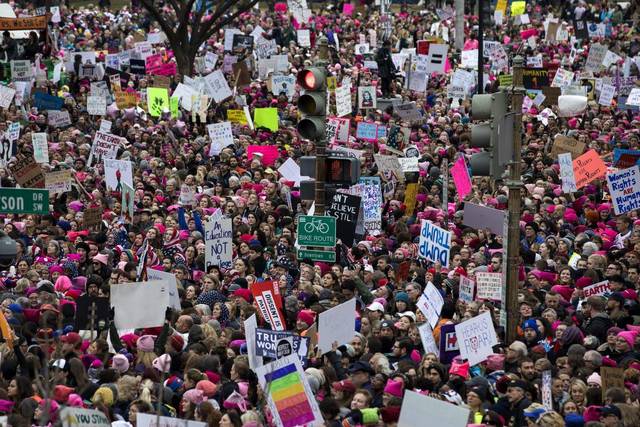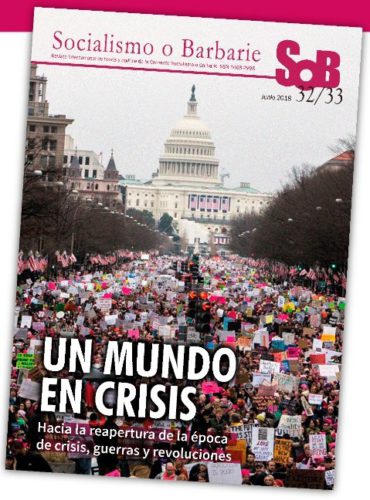
Compartir el post "Massive «Women’s March» inaugurates the resistance against Trump"
If Trump’s inauguration was marked by the most important protest in any US presidential inauguration, his first day in office didn’t fall short. With over half a million people marching the streets of Washington DC, and millions across the country -only comparable to anti Vietnam War protests- Women’s March served as a clear message of dissent and resistance to Trump’s starting presidency.
However, though women’s and LGBT rights where a main part of the march’s agenda, its political content extended to most of the oppressed and exploited’s demands with a common denominator: The rejection of Donald Trump and all he represents as a multimillionaire, xenophobic and misogynist bigot.
Trump’s upcoming as leader of the world’s main economic and military power is the confirmation of a worldwide rightwards tendency as expressed by Brexit and the steady surge of conservative nationalism in Europe, and by Macri and Temer’s governments in Argentina and Brazil, to name some examples. This confirmation, now exemplified by such a grotesque bigot, explains not only the massive affluence to DC of demonstrators from all over the US and neighbour countries, but also the wide array of ‘sister marches’, rallies and protests that took place all over the world.
This also explains how, despite the last minute effort by the organizers -clearly in line with the Democrats- to cancel the official march to avoid things from getting out of hand, the massive rally overran them and took to the streets. As though magnetized, the crowd made its way to Trump’s hotel and the White House, on the same Pennsylvania Avenue the president paraded the day before.
Men, women, US citizens, migrants, black, white, working and middle class people mobilized through the streets of Washington making each other’s demands their own and, in many cases, making their first experience in political street struggle. The drive and morale of the crowd was embodied in chants such as “¿Whose streets?/ Our Streets!”, “Show me what democracy looks like/ This is what democracy looks like!” o “My body, my choice/ Her body her choice”; in the greatly progressive slogans of solidarity, protest and struggle seen on placards and in the general atmosphere of the street.
When the rally spontaneously took to the streets and began to fill the White House’s hinterland, it was an unstoppable force, partially because no one anticipated such an overflow. It was only around an hour later that the police was able to split the demonstration in two, making a gap in the middle of the park and trying to decompress the rally without a frontal confrontation that could have had any outcome for either side. Immediately afterwards and for several hours on, people kept circulating through that intersection, renewing the crowd but maintaining a critical mass that chanted at the top of it’s voice against Trump and Pence, against the system and its oppression.
Only several hours later the march begun to slowly dwell, with protesters leaving behind their signs against the park’s fences in an almost ritualistic manner, covering most of the White House posterior parkland. At dusk some 120 people remained chanting and agitating behind the White House, when another 250 protesters arrived from a rally at Trump’s hotel. Finally at around 8.00 PM the crowd marched in high spirits to 13th and K streets, where clashes had taken place the day before and where a festival with live bands was taking place.
Trump is the first US president to take office with such a magnitude of domestic and international protest. It’s a first landmark to be set in the resistance against his regressive, bigot agenda and a lesson of international solidarity to be developed further in order to effectively face this reactionary nationalistic right. A right that looms over the whole world and anticipates increasing class tensions and clashes.
But if Trump is a rightwing reaction to the globalized neoliberal consensus, this movement is a leftwing reaction to Trump, which is an enormously progressive element and holds many potentials, but also has clear limits to surpass. In the US prevails an enormous expectation on Obama -whose approval rates just hit 60%, according to local polls), on the Democrats as an alternative to defeat Trump… four years from now! Some are hopeful of a Congress impeachment will stop him before that, while the left remains weak and disarrayed.
This was visible in the constant decentralization of marches and protests, with some radicalized actions though minoritary and split up from the movement as a whole, and in some very massive actions that retreated at the mere sight of law enforcement or after a few commands to halt.
In order to succeed, to overcome Trump, this movement must not only make more experience in the day to day struggles (and many more will come), but also learn from the historical experiences of the working class, its struggle and methods, specially those of its most advanced, revolutionary elements. Not only that, the movement must win over the working class to this side of the struggle. The movement must realize that Trump can’t be faced as ‘one nation’ with the Democrats -accesory to his government from Obama to Bernie Sanders- or the Greens, but as one class, shoulder to shoulder with the workers, women and youth of every color, raze or nationality to which this fresh republican president has declared war.
Correspondent from Washington for Socialism or Barbarism


